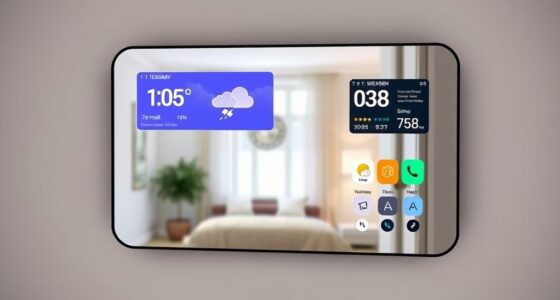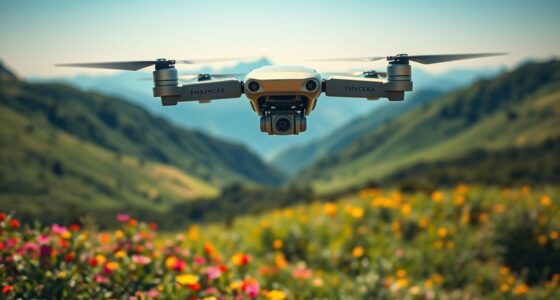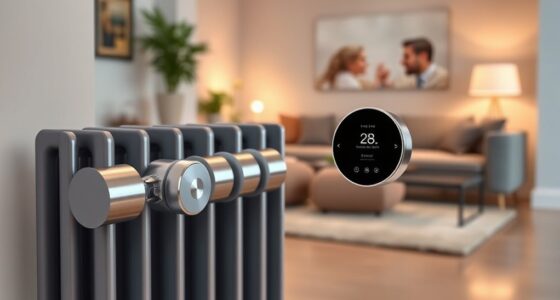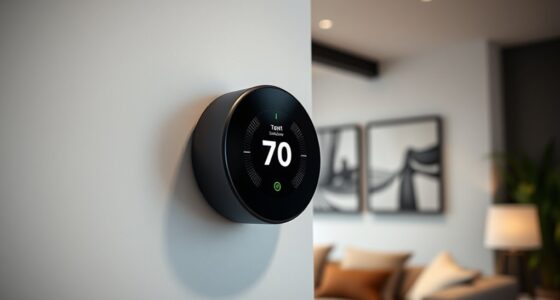If you’re looking to open your creative potential with the best lidar scanners in 2025, I’ve got you covered. I’ve compiled a list of top options, from handheld and portable models to professional-grade sensors ideal for robotics and mapping projects. Whether you’re working on drones, 3D modeling, or environment mapping, these devices can elevate your work. Keep exploring, and I’ll show you the key features and what makes each one perfect for creators like you.
Key Takeaways
- Top lidar scanners for creators in 2025 feature high-precision 3D mapping and environmental scanning capabilities.
- Portable and lightweight models enable on-the-go capturing for diverse creative projects.
- Compatibility with popular SDKs and ROS enhances integration into custom workflows and applications.
- Durable, outdoor-ready sensors support outdoor environment mapping and outdoor drone use.
- Advanced features like wireless data transmission and anti-shake ensure accurate, real-time scans for innovative workflows.
IX500 Fujitsu Receipt Scanner for Mac & PC

If you’re looking for a reliable scanner that quickly digitizes large volumes of documents and photos, the Fujitsu IX500 Receipt Scanner for Mac & PC is an excellent choice. It features high-speed duplex scanning, an automatic document feeder, and wireless connectivity, making it easy to use without cables. With the ability to scan up to 30 pictures in about 25 seconds, it offers both speed and quality. Its compact design fits well in home or office setups. Users praise its ease of use, reliable performance, and sharp images, especially when digitizing papers for archiving or going paperless. It’s a versatile tool for efficient document management.
Best For: users seeking a fast, reliable, and user-friendly scanner for digitizing large volumes of documents and photos at home or in the office.
Pros:
- High-speed duplex scanning of up to 30 pictures in approximately 25 seconds
- Wireless connectivity for cable-free operation and easy setup
- Compact design with user-friendly features, ideal for both personal and professional use
Cons:
- Often purchased as a refurbished product, which may arrive in plain packaging and could have variable condition
- Compatibility issues reported with older operating systems like Windows 7
- No longer available as a new product through official channels, limiting availability of brand-new units
Fujitsu FI-7160 Document Scanner

The Fujitsu FI-7160 Document Scanner stands out as a high-performance choice for busy offices and professional creators who demand fast, reliable duplex scanning. With 60 pages per minute at 600 DPI, it handles large volumes effortlessly, making it ideal for high-volume tasks. Its 80-sheet Automatic Document Feeder supports double-sided scans of various document sizes, including large formats. Though praised for speed and ease of setup, some users report feeding issues and software challenges, especially after Fujitsu’s acquisition by Ricoh. Overall, it’s a durable, efficient scanner perfect for demanding workflows, provided you maintain it well and ensure proper driver support.
Best For: busy offices and professional creators who require fast, reliable duplex scanning of large document volumes.
Pros:
- Fast scanning speed of 60 pages per minute at 600 DPI, ideal for high-volume tasks
- Supports double-sided scanning with an 80-sheet Automatic Document Feeder, accommodating various document sizes
- Seamless integration with software, making it versatile for professional use
Cons:
- Reports of feeding issues such as multiple pages pulling through simultaneously
- Software and driver support can be challenging, especially after Fujitsu’s acquisition by Ricoh
- Some units may have durability concerns, including broken feeders or malfunctions requiring maintenance
Yahboom MS200 Handheld Scanning Lidar for Robotics Projects

The Yahboom MS200 Handheld Scanning Lidar stands out for its wireless data transmission capabilities, making it ideal for robotics enthusiasts who want real-time mapping without tethering their devices. It offers 360-degree scanning up to 12 meters, supporting multiple versions like X3PRO and TMINI PLUS for precise positioning and obstacle avoidance. Compatible with Raspberry Pi 5, Jetson Nano, and ROS systems, it supports open Python code and detailed tutorials. Using MicroROS, it transmits data via WiFi-UDP, enabling remote viewing on mobile apps. Its 6-axis IMU enhances accuracy, while anti-shake alerts prevent data distortion, making it perfect for versatile robotics projects.
Best For: robotics enthusiasts and developers seeking wireless, real-time 3D mapping and obstacle avoidance capabilities with easy integration across multiple platforms.
Pros:
- Wireless data transmission via MicroROS allows for flexible remote operation and real-time mapping.
- Supports multiple versions and compatible with popular controllers like Raspberry Pi 5 and Jetson Nano for versatile applications.
- Equipped with a 6-axis IMU and anti-shake alerts to improve data accuracy and reliability during operation.
Cons:
- VM software for PC virtual machines is not supported on Mac, limiting cross-platform flexibility.
- May require additional setup and tutorials for beginners unfamiliar with ROS or SDK integration.
- Limited to a maximum scanning range of 12 meters, which might not suit large-scale mapping needs.
youyeetoo FHL-LD19 Lidar Sensor with SDK for Robots and Drones

Designed for creators building robots and drones, the youyeetoo FHL-LD19 Lidar Sensor stands out with its extensive SDK support for ROS, ROS2, C, and C++. It uses Time-of-Flight technology to measure distances up to 12 meters with ±45 mm accuracy, providing high-precision indoor and outdoor mapping. Its 360-degree scanning, silent brushless motor, and durability—lasting up to 10,000 cycles—make it reliable in various environments. Compact and lightweight (under 50 grams), it easily integrates into platforms like Raspberry Pi. With robust environmental resistance and all-encompassing SDKs, this sensor is ideal for versatile robotic applications.
Best For: robotics enthusiasts, drone developers, and engineers seeking high-precision, versatile LiDAR sensors for indoor and outdoor mapping and navigation.
Pros:
- High-precision measurements with ±45 mm accuracy up to 12 meters, ensuring reliable mapping.
- 360-degree scanning with silent brushless motor, providing comprehensive environmental data quietly.
- Compact, lightweight design (<50g) and durability up to 10,000 cycles facilitate easy integration into various platforms.
Cons:
- Limited effective range of 12 meters may not suit applications requiring longer-distance scanning.
- Requires familiarity with SDKs and programming in ROS, C, or C++ for optimal use, which could be a barrier for beginners.
- Environmental resistance up to 30,000 lux may still be challenged in extremely bright outdoor conditions.
WayPonDEV LD14P 2D 360° Lidar Sensor for Robot Navigation
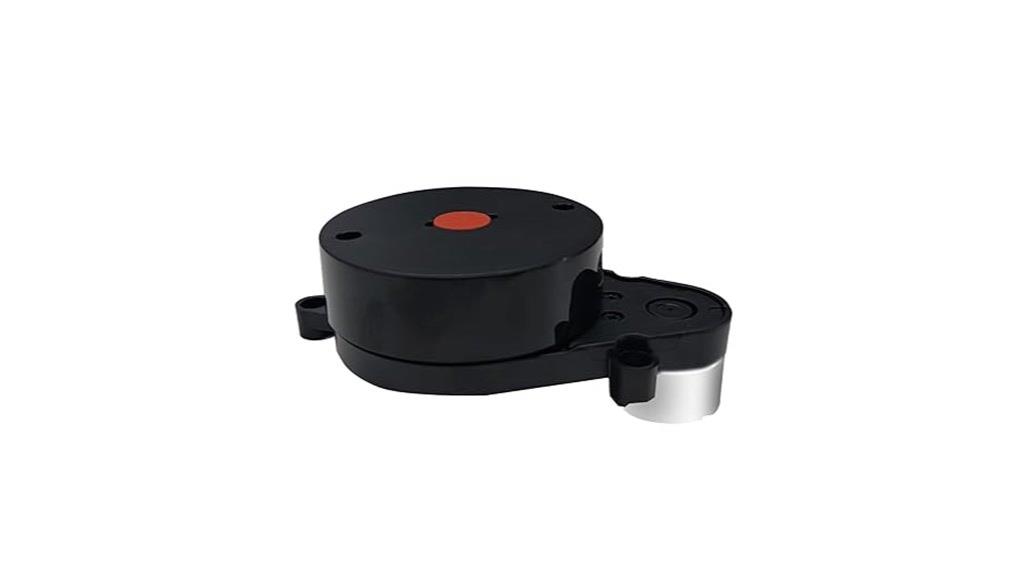
If you’re looking for a reliable sensor that provides exhaustive environmental awareness, the WayPonDEV LD14P 2D 360° Lidar Sensor is an excellent choice for robot navigation. It combines traditional triangulation radar technology with LDROBOT’s advanced algorithms, delivering high-precision mapping and obstacle detection. With a detection range of up to 8 meters, it captures detailed environmental contours from a distance, improving navigation accuracy. Its lightweight, compact design makes integration straightforward, and features like dust protection and anti-winding ensure durability. Plus, its filtering technology resists ambient light interference, enabling reliable performance indoors and outdoors, making it ideal for diverse robotic applications.
Best For: robotics developers and engineers seeking a high-precision, durable 360° lidar sensor for indoor and outdoor navigation and obstacle avoidance.
Pros:
- High-precision environment mapping with up to 8-meter detection range.
- 360-degree detection capability provides comprehensive environmental awareness.
- Compact, lightweight design with dust cover and anti-winding features for durability and ease of integration.
Cons:
- May require compatible hardware and software for optimal performance.
- Performance can be affected in environments with extreme ambient light levels above 80,000 lux.
- Limited to a 2D sensing plane, which may not be sufficient for complex 3D mapping needs.
RPLIDAR A1M8 2D 360° 12m LIDAR Sensor for Robots
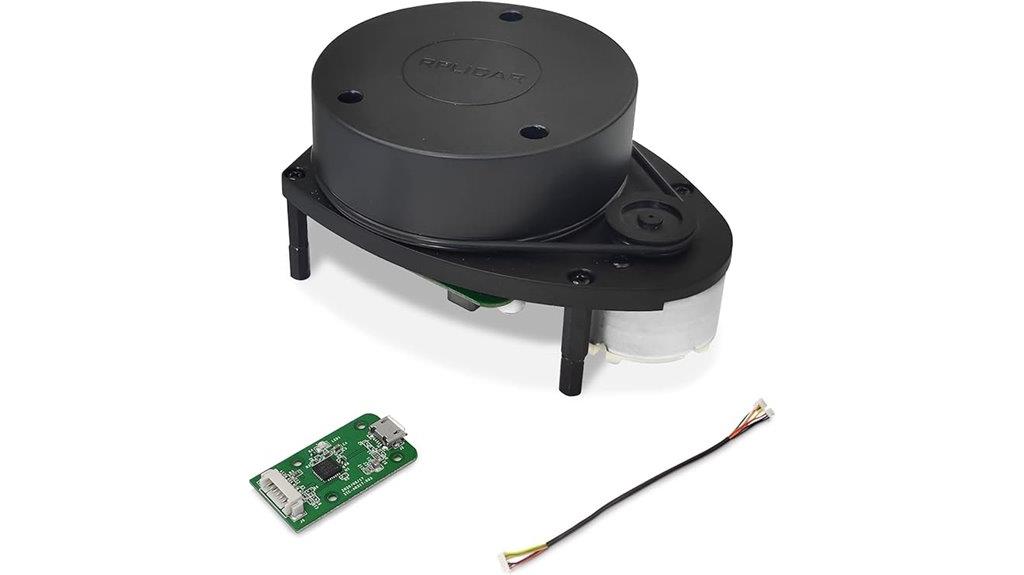
For creators developing robots that require precise obstacle detection and navigation, the RPLIDAR A1M8 offers a reliable 360° scanning solution with a range of up to 12 meters. Its high sample rate of 8,000 scans per second guarantees fast, accurate data collection, while the configurable scan rate from 2 to 10Hz provides flexibility for various applications. Designed with durability in mind, it features the OPTMAG design for longevity. Easy to install with compatible M2.5 screws, the RPLIDAR A1M8 is straightforward to incorporate into your projects. Its omnidirectional laser scanning makes it ideal for obstacle avoidance, mapping, and localization tasks.
Best For: robotics developers and engineers seeking a durable, high-speed 360° LIDAR sensor for obstacle avoidance, mapping, and navigation in various robotic applications.
Pros:
- High sample rate of 8,000 scans per second ensures fast and accurate data collection
- Configurable scan rate from 2 to 10Hz allows customization for different tasks
- Durable OPTMAG design extends lifespan and reliability
Cons:
- Requires a 5V power supply, which may necessitate additional power management
- Compatibility depends on mounting hole size (M2.5 screws), potentially limiting some installations
- Limited to 2D scanning; not suitable for 3D mapping or complex spatial analysis
WayPonDEV FHL-LD19 360° 2D Lidar Distance Sensor Kit
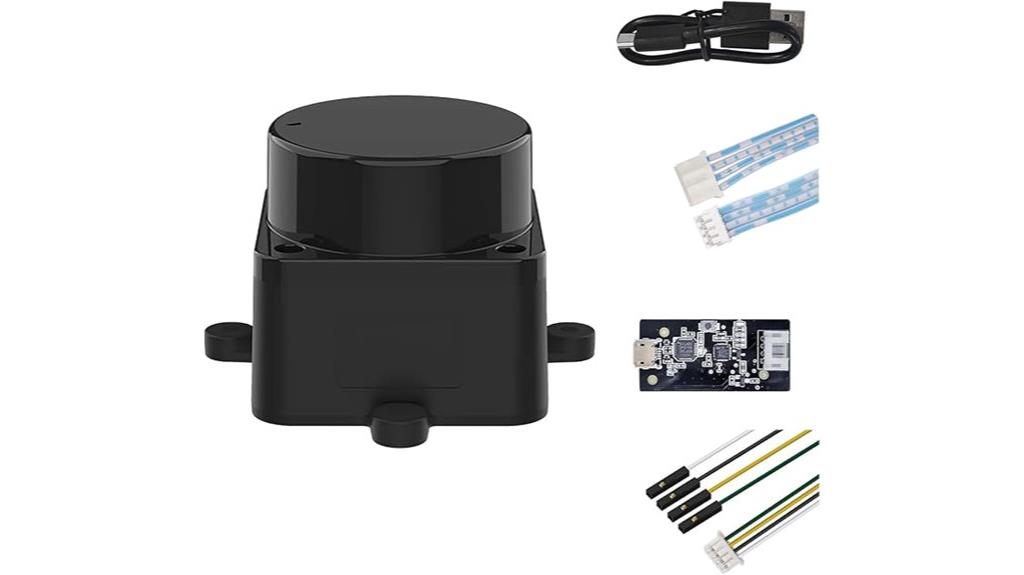
The WayPonDEV FHL-LD19 360° 2D Lidar Distance Sensor Kit stands out with its high accuracy range of up to 12 meters on white objects and a rapid sampling rate of 8,000 times per second. This makes it ideal for real-time environment mapping and obstacle detection. Its 360-degree omnidirectional scanning provides extensive data, while the configurable scan rate ensures flexibility for different tasks. Designed for plug-and-play use, it features built-in serial and USB interfaces, plus open-source SDKs and ROS support. Whether for robotics, SLAM, or 3D modeling, this sensor offers precise, durable, and easy-to-integrate lidar capabilities for creators.
Best For: robotics enthusiasts, developers, and researchers seeking precise 360° environment scanning and obstacle detection for indoor and outdoor applications.
Pros:
- High accuracy measurement up to 12 meters on white objects with 70% reflectivity
- Rapid sampling rate of 8,000 times per second ensures real-time data collection
- Plug-and-play design with built-in serial and USB interfaces simplifies integration
Cons:
- Requires a compatible system or platform to fully utilize SDKs and ROS support
- May be less effective on non-white or highly reflective surfaces beyond 12 meters
- Limited information on customization options for different scanning configurations
WayPonDEV SSL-20L Lidar Sensor Scanner
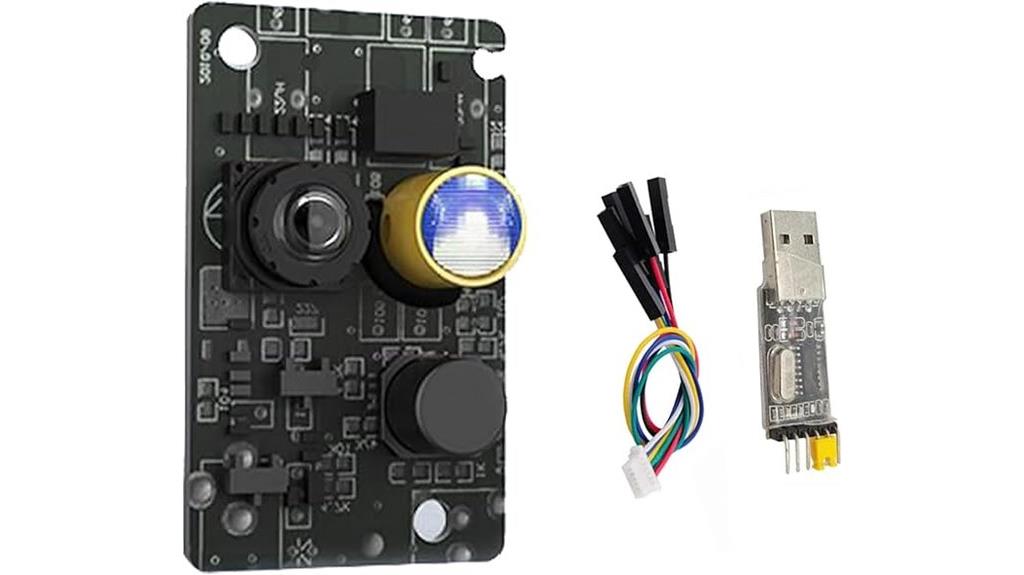
The WayPonDEV SSL-20L Lidar Sensor Scanner stands out for its compact design and high-precision detection capabilities, making it an ideal choice for creators building small robots or drones. Operating at 24Hz with a 100° field of view, it offers reliable obstacle detection within a 200mm range, with less than 10mm accuracy along walls. Its anti-glare features and advanced filtering guarantee consistent performance even in bright environments. Easy to integrate into various robotic platforms, the SSL-20L enhances maneuverability and safety. Whether indoors or outdoors, it supports real-time obstacle avoidance, empowering creators to develop smarter, more responsive autonomous systems.
Best For: creators and developers building small robots or drones who need high-precision obstacle detection and reliable navigation in indoor and outdoor environments.
Pros:
- Compact design facilitates easy integration into various robotic platforms
- High-precision detection with less than 10mm accuracy along walls and up to 200mm range
- Effective anti-glare and filtering technology ensures stable performance in bright lighting conditions
Cons:
- Limited measurement range of up to 200mm may not suit applications requiring longer-distance sensing
- Operating at 24Hz may be insufficient for extremely fast-moving scenarios
- Requires SDK download and technical integration, which may be challenging for beginners
RPLIDAR A1M8-R6 LIDAR Sensor Kit for Robots

If you’re working on robotics projects that demand precise obstacle detection and environment mapping, the RPLIDAR A1M8-R6 is an excellent choice due to its 360-degree omnidirectional scanning within a 6-meter range. It produces high-resolution 2D point cloud data, perfect for navigation, SLAM, and environment modeling. Compact and lightweight, it’s easy to integrate into various robotic systems, offering a sampling rate over 8000 times per second and a scan rate up to 10Hz. Its durable design and plug-and-play setup make it ideal for indoor and outdoor applications, including home robots, cleaning devices, and smart toys.
Best For: robotics enthusiasts and developers seeking precise obstacle detection, environment mapping, and navigation solutions for indoor and outdoor robotic applications.
Pros:
- High-resolution 2D point cloud data with a sampling rate over 8000 times/sec for accurate mapping and obstacle detection.
- 360-degree omnidirectional scanning within a 6-meter range, ideal for comprehensive environment awareness.
- Plug-and-play setup with durable, lightweight design suitable for various robotic systems, including home service robots and smart toys.
Cons:
- Power source not included, requiring an external battery or power supply for operation.
- Limited to 2D scanning; not suitable for 3D environment modeling.
- Range quality may diminish in bright outdoor conditions or highly reflective surfaces.
Canon Canoscan Lide 300 Scanner (PDF, AUTOSCAN, COPY, SEND)
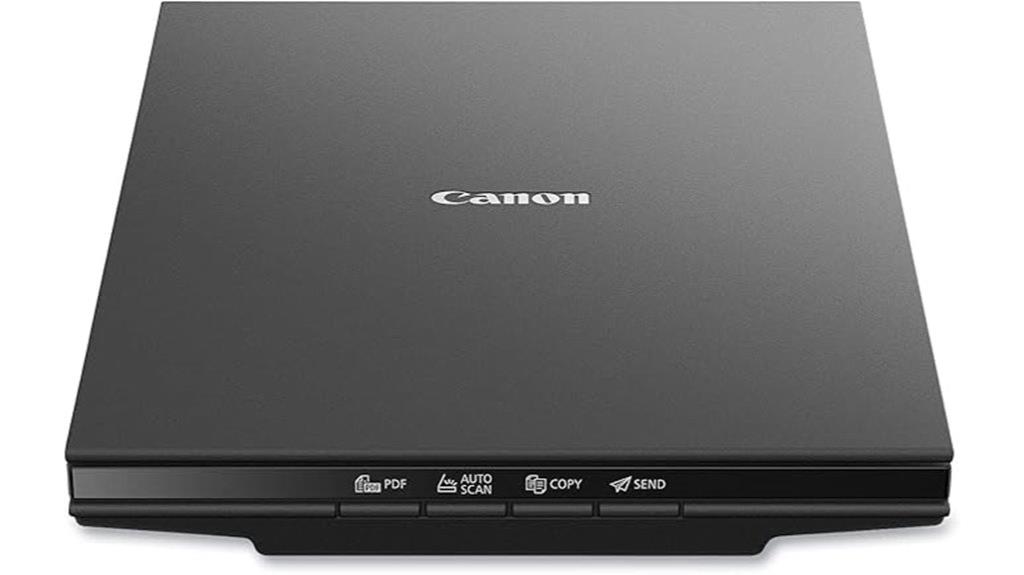
For creators seeking a compact, reliable scanner that easily digitizes documents and photos, the Canon Canoscan Lide 300 stands out with its 2400 x 2400 dpi resolution and quick 10-second scan speed. Its four EZ Buttons make tasks like PDF creation, auto scan, copying, and sending effortless. Powered via USB, it’s lightweight and portable, fitting easily into any workspace. The flatbed design handles documents up to letter size, producing detailed color scans suitable for artistic projects or professional use. While it lacks automatic page detection, manual operation is simple, and third-party software like VueScan can enhance functionality. Overall, it’s a versatile, budget-friendly option for quick, high-quality scans.
Best For: creators and home users seeking an affordable, compact scanner for quick, high-quality document and photo digitization.
Pros:
- Easy to set up and operate with minimal software requirements
- Compact, lightweight, and portable design ideal for small spaces or on-the-go use
- High-resolution scans (up to 2400 x 2400 dpi) produce detailed images suitable for artistic and professional projects
Cons:
- Manual page detection required as it lacks automatic detection feature
- Flimsy lid and stiff lock slide may affect durability and ease of use during setup
- Short 48-inch USB cable could limit placement options and convenience
Slamtec RPLIDAR A1M8-R6 with MX1.25 to 2.54 Dupont Wire Kit
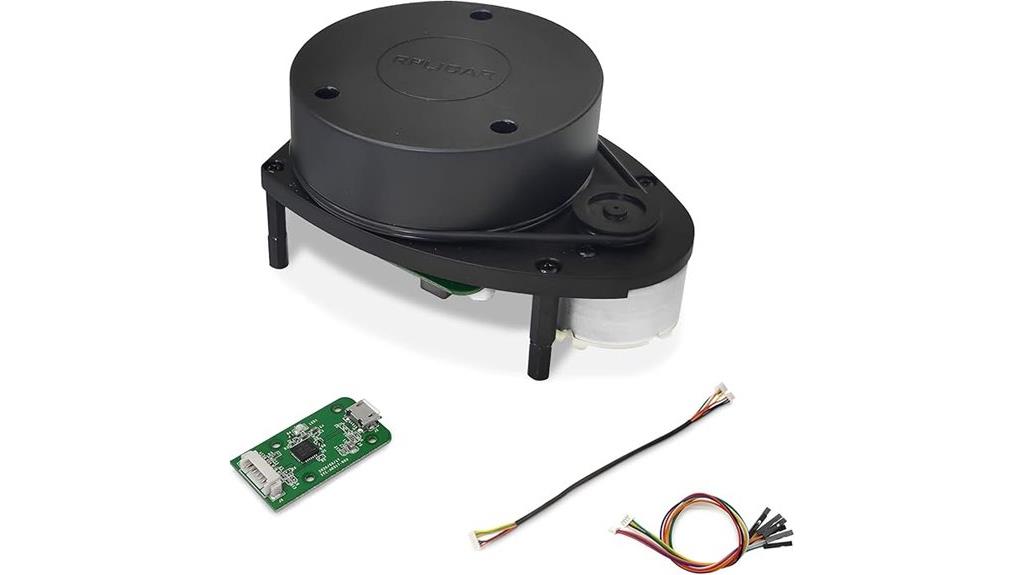
Anyone looking to integrate a reliable, high-resolution lidar sensor into their robotics projects will find the Slamtec RPLIDAR A1M8-R6 with MX1.25 to 2.54 Dupont Wire Kit an excellent choice. This compact, 2D omnidirectional sensor offers a 12-meter scanning radius and generates over 8,000 measurements per second, making it perfect for obstacle avoidance, navigation, and mapping. Its adjustable scan rates from 2 to 10Hz ensure flexibility for various applications. The kit includes everything needed for easy setup, including a USB adapter compatible with Raspberry Pi and Jetson Nano, plus wiring options for seamless integration into diverse robotic platforms.
Best For: robotics enthusiasts and developers seeking a high-resolution, easy-to-integrate 2D lidar sensor for obstacle avoidance, navigation, and SLAM applications.
Pros:
- High-resolution scanning with a 12-meter radius and over 8,000 measurements per second for detailed environmental data
- Adjustable scan rates (2-10Hz) providing flexibility for various robotic tasks
- Compact, lightweight design (170g) with comprehensive kit for straightforward setup and integration
Cons:
- Limited to 2D scanning; not suitable for 3D mapping needs
- Requires compatible platforms like Raspberry Pi or Jetson Nano for optimal use, which may necessitate additional hardware setup
- Performance may be affected in highly reflective or transparent surfaces, common limitations for lidar sensors
Epson WorkForce ES-50 Portable Sheet-Fed Document Scanner for PC and Mac

The Epson WorkForce ES-50 Portable Sheet-Fed Document Scanner stands out as an ideal choice for mobile creators who need quick, reliable scanning on the go. It’s the lightest, fastest scanner in its class, scanning a page in just 5.5 seconds. Compatible with Windows and Mac, it handles documents up to 8.5 x 72 inches, ID cards, and receipts effortlessly. Powered via USB, it’s compact and lightweight—perfect for travel, home, or office use. With Epson ScanSmart and Nuance OCR, it simplifies digitizing, editing, and cloud storage. Despite some driver quirks, its speed, portability, and ease of use make it a top option for creators needing versatile, on-the-move scanning.
Best For: mobile professionals, creators, and small businesses seeking a lightweight, fast, and portable scanner for on-the-go document digitization.
Pros:
- Extremely portable and lightweight, ideal for travel and limited desk space
- Fast scanning speed of just 5.5 seconds per page
- Compatible with Windows and Mac, supporting various document types including receipts and IDs
Cons:
- No multi-page feed capability, limiting batch scanning efficiency
- Occasional issues with sleep mode and driver compatibility, especially on Windows 10/11 and older Mac OS versions
- Limited contrast adjustment and challenges scanning faint or glossy documents
Epson Perfection V19 II Flatbed Scanner
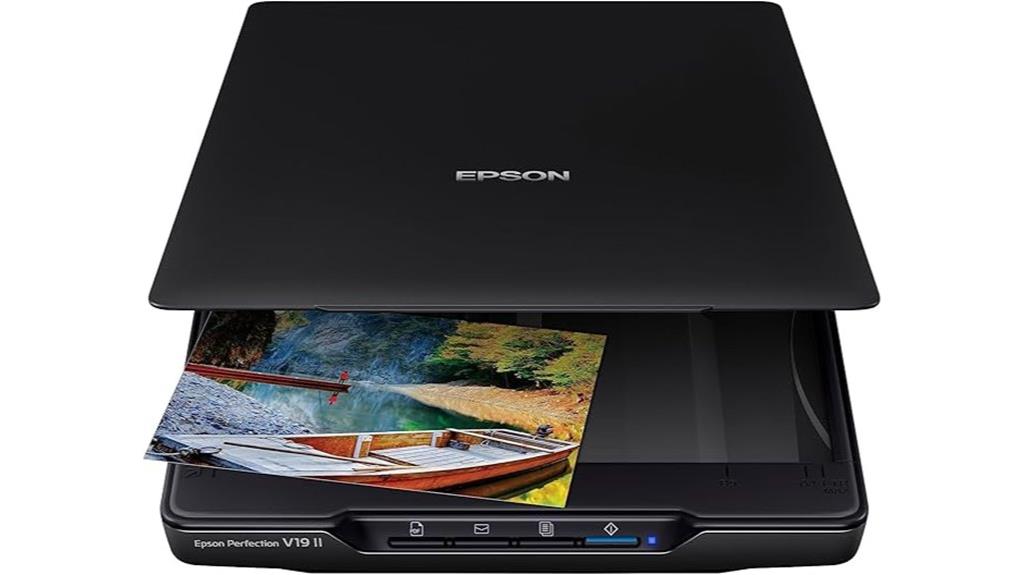
Epson Perfection V19 II stands out as an excellent choice for creators seeking a portable, high-resolution scanner that can handle photos, artwork, and documents with ease. Its 4800 dpi resolution delivers sharp, detailed images, perfect for enlargements or restoring faded photos with Easy Photo Fix technology. The compact, lightweight design, powered via USB, makes it easy to carry and set up anywhere. The removable lid accommodates bulky items like albums or books, and one-touch buttons simplify quick scans to PDF or email. While software quirks exist, modern systems generally provide smooth performance, making this scanner ideal for light to moderate creative workflows on the go.
Best For: creators and hobbyists seeking a portable, high-resolution scanner for photos, artwork, and documents with quick, easy operation.
Pros:
- High 4800 dpi resolution delivers sharp, detailed scans ideal for enlargements and restorations
- Compact, lightweight, and USB-powered for easy portability and space-saving storage
- User-friendly with one-touch scan buttons and versatile software features for quick digitization
Cons:
- Occasional software inconsistencies and slow processing on older or less powerful computers
- Reports of durability issues after prolonged use, suggesting it may be better suited for light to moderate use
- Minor inconveniences like edge cropping and potential connectivity issues during setup
Factors to Consider When Choosing Lidar Scanners for Creators
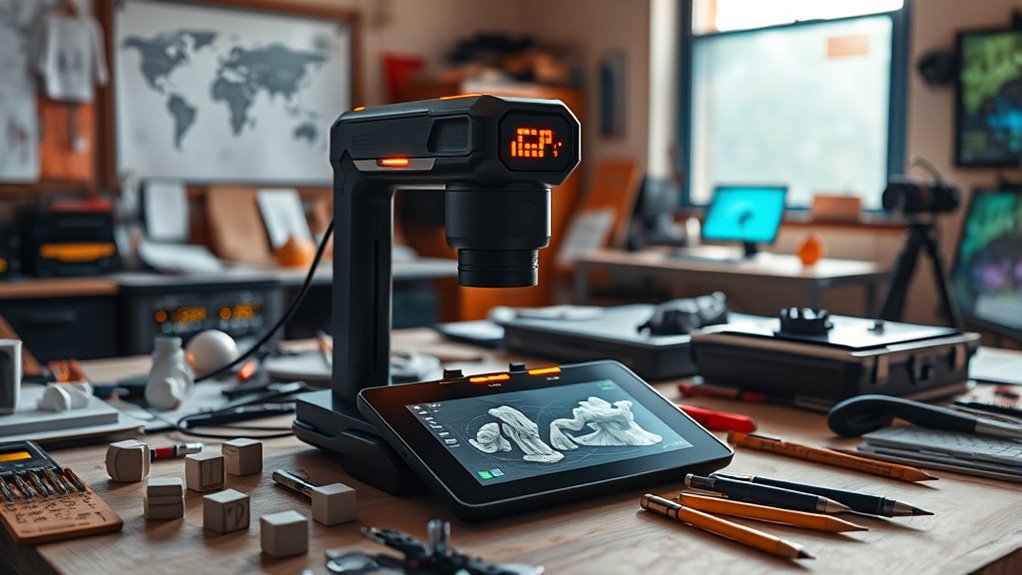
When choosing a lidar scanner, I look at factors like measurement range and accuracy to guarantee it meets my project needs. Compatibility with my existing tools and how easy it is to integrate also play a big role. Plus, I consider portability, software support, and environmental durability to find the best fit for my creative work.
Measurement Range & Accuracy
Choosing the right lidar scanner depends heavily on its measurement range and accuracy, as these factors determine whether it can meet your project’s specific needs. Some models can detect objects up to 12 meters away, making them suitable for larger spaces or outdoor use. Accuracy is typically measured in millimeters or centimeters; high-precision lidar can achieve ±45 mm or better, which is essential for detailed mapping and navigation. Keep in mind that environmental factors like lighting, surface reflectivity, and ambient light can affect both range and accuracy. Longer measurement ranges usually require more powerful lasers and sensors, which can increase size, cost, and power consumption. Ultimately, balancing range and precision is key to selecting a lidar scanner that aligns with your creative goals.
Compatibility & Integration Ease
Selecting a lidar scanner that easily integrates with your existing setup can save you time and reduce frustration. First, guarantee it supports your operating system and hardware, whether you’re using a Raspberry Pi, Jetson Nano, or a Windows PC. Check if the device offers compatible SDKs or APIs like ROS, C++, or Python, so you can seamlessly incorporate it into your projects. Confirm the communication interfaces—USB, UART, or WiFi—match your system’s connectivity options for straightforward setup. It’s also helpful if the scanner provides open-source support, tutorials, and detailed documentation to ease integration and customization. Finally, verify driver availability and software updates to ensure reliable operation within your preferred development environment. These factors will make your creative process smoother and more efficient.
Size & Portability
Size and portability are vital factors that can make or break your experience with a lidar scanner. Smaller sensors, like compact solid-state models around 54x46x35mm, are perfect for projects with limited space and when mobility matters. Lightweight units, often under 200 grams, enable quick deployment and seamless integration into mobile devices or handheld robots. Portable lidar scanners usually feature simplified wiring and wireless data options, making setup straightforward and hassle-free. The size of the scanner also influences power consumption and battery life; smaller devices tend to use less energy, extending operational time. If you’re working on drones, handheld tools, or small robotic platforms, choosing a compact, lightweight lidar guarantees ease of use and flexibility, releasing your creative potential wherever your ideas take you.
Software & SDK Support
When evaluating lidar scanners for creative projects, software and SDK support play a crucial role in ensuring smooth integration and efficient development. I look for extensive SDKs that support popular languages like C++, Python, and ROS, making it easier to embed lidar data into my workflows. It’s essential that manufacturers provide clear APIs, detailed documentation, tutorials, and sample code to speed up development and troubleshooting. Compatibility with my operating system—whether Windows, Mac, or Linux—is critical to avoid integration issues. I also check if the SDK offers real-time data streaming, calibration tools, and customization options to tailor performance to my needs. Finally, ongoing software updates and an active developer community are invaluable for long-term usability and support as my projects evolve.
Environmental Resistance
Considering the environmental conditions in which my lidar scanner will operate is essential to ensuring reliable performance. Bright sunlight, especially up to 30,000 lux, can cause measurement errors, so I look for models with strong anti-glare and advanced filtering technology. Durability is also vital; I need sensors resistant to dust, water, and temperature changes to handle outdoor or industrial use. Some high-performance models can operate reliably in environments with up to 80,000 lux, ensuring consistent data collection both indoors and outdoors. I also prioritize scanners with robust protective enclosures or dust covers to prevent mechanical damage and maintain calibration over time. These features help me trust my lidar’s accuracy and resilience, no matter the challenging environmental conditions I face during my creative projects.
Power & Connectivity Options
Have you thought about how your lidar scanner’s power and connectivity options impact your workflow? Choosing the right power sources is vital—look for USB, batteries, or AC adapters to match your mobility needs. Wireless connectivity like WiFi or Bluetooth can free you from cables, making setup quicker and more flexible. Support for open-source SDKs and APIs is also essential, as it allows seamless integration with your existing tools and custom programming. Check the device’s power consumption to guarantee it aligns with your portable projects or battery life expectations. Additionally, having multiple connectivity ports such as serial, USB, or GPIO increases versatility, letting you connect with various hardware and platforms. Prioritizing these factors ensures your lidar scanner fits smoothly into your creative process.
Frequently Asked Questions
How Do Lidar Scanners Integrate With 3D Modeling Software?
When I ask how lidar scanners integrate with 3D modeling software, I find that most scanners export data in formats like OBJ or PLY, which are easy to import. I usually connect the scanner to my software, like Blender or SketchUp, and then clean up or refine the point cloud data. This seamless integration helps me create detailed, accurate 3D models quickly, enhancing my creative workflow.
What Are the Maintenance Requirements for High-End Lidar Devices?
Think of a high-end lidar device as a fine-tuned instrument that needs regular care. I keep my lidar clean and dust-free, especially the sensors, to prevent measurement errors. I also make sure to update the firmware and calibrate it periodically. Storing it in a dry, cool place helps prevent damage. Proper maintenance guarantees my device remains reliable, precise, and ready to capture the world’s details whenever I need it.
How Does Environmental Lighting Affect Lidar Scanning Accuracy?
Environmental lighting definitely impacts lidar scanning accuracy. Bright sunlight, especially, can cause interference because the laser signals may blend with ambient light, reducing precision. I’ve noticed that scanning in low-light or consistent lighting conditions generally yields better results. To get the most accurate scans, I try to avoid direct sunlight and scan indoors or in shaded areas whenever possible. Adjusting scanner settings can also help mitigate lighting effects.
Can Lidar Scanners Be Customized for Specific Creative Projects?
Imagine tailoring a tool to fit your unique vision—that’s exactly what customizable lidar scanners can do for your creative projects. I’ve found that many models allow adjustments in scanning resolution, range, and data processing settings. This flexibility helps me capture intricate details or large spaces, depending on my needs. So, yes, lidar scanners can definitely be customized, empowering you to bring your artistic ideas to life with precision and ease.
What Is the Typical Learning Curve for New Lidar Users?
The typical learning curve for new lidar users can vary, but I’d say it’s usually moderate. At first, I spend some time understanding the software and how to capture accurate scans. With practice, I get more comfortable, and the process becomes smoother. I recommend starting with simple projects to build confidence. Overall, patience and hands-on experience are key to mastering lidar technology quickly.
Conclusion
Remember, a good craftsman never blames their tools, but choosing the right lidar scanner can make all the difference. Whether you’re into robotics, 3D modeling, or creative projects, the perfect device opens your potential. Trust me, investing in the right scanner today sets you up for success tomorrow. So, don’t just work harder—work smarter, and let these top options elevate your creative game to new heights.



